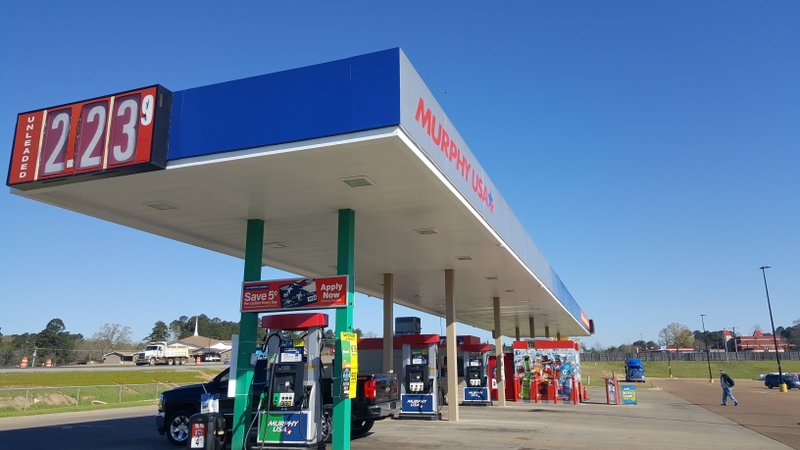With oil prices rising sharply over the past days and weeks, consumers are now seeing higher costs at the pump.
In a recent report from the fuel survey and data company Gasbuddy, the national regular fuel price average is up 35 cents since January, equating to an extra $135-million spent per day now on fuel.
“It’s been nothing short of madness at the pumps since early January with retail gasoline prices on a tear,” said Patrick DeHaan, head of petroleum analysis at GasBuddy.
Price spikes were seen highest in the midwest — some states such as Michigan and Ohio had 75-cent and 67-cent jumps, respectively, in recent weeks — but southern and mid-south states weren’t far behind. In Arkansas, gas prices have jumped 45 cents over their lowest point in 2019, according to the data company, while the Columbia County area has seen prices jump nearly 25 cents in a month.
On Feb. 19, the average countywide regular gasoline cost per gallon was reported at $2.18. But on Thursday morning, the average observed per gallon cost across 10 major pump retailers in Magnolia was $2.42 per gallon. Stations included advertised costs at Magnolia Travel Center, Valero Superstop, Hwy. 79 Exxon, Hwy. 82 B Exxon and Mobil stations, Vine Street Dixie Mart, W. Main Street Dixie Mart, Rider Express E-Z Mart, Murphy USA, and North Vine Express. The cheapest regular octane price observed was $2.23 per gallon at Murphy USA, while the most expensive ethanol-containing gasoline was $2.45 per gallon at Exxon Dixie Marts and Mobil. The costliest gasoline overall was $2.73 per gallon fuel at N. Vine Street’s Exxon, but the fuel comes with benefits of being pure and ethanol-free, thus the higher price.
The state per gallon average, according to U.S. Department of Energy data, on Feb. 9 was $1.98 per gallon.
Diesel fuel in Magnolia averaged $2.92 per gallon. Of three observed stations — Valero Superstop, Magnolia Travel Center, and Murphy USA — the latter was the cheapest at $2.79 per gallon. The remaining stations each had observed prices of $2.99 per gallon.
So, what has caused this shift pricing? In short — rising crude prices due to lesser world market supply. The price of oil on Wednesday hit $60 a barrel for the first time since November. WTI (West Texas Intermediate) crude has climbed 30 percent year to date, according to Bloomberg.
In a Jan. 7 Wall Street Journal report, OPEC said it would begin a drawdown in crude exports in an attempt to drive the cost of oil up to $80 per barrel in a sagging market. The move has worked well for them. The middle eastern cartel on Wednesday even canceled an April meeting, electing instead to continue withholding 1.2 million barrels from the international market, at least until June, according to CNBC.
The overseas export reduction has also caused domestic supply to be used more rapidly, thus boosting prices at the pump.
“Oil closed at a new high for the year in New York after the biggest withdrawal of crude in U.S. storage tanks since July signaled further tightening supplies,” said a March 19 Bloomberg report. “Futures gained 1.4 percent on Wednesday after a 9.59 million-barrel decline in American oil stockpiles reported by the government exceeded analysts’ expectations.”
But OPEC alone is not the only causation of the crude uptick. In January, the United States enacted strict sanctions virtually shutting off all oil imports from Venezuela in an attempt to squeeze the totalitarian, corrupt, anti-American socialist regime of Nicolás Maduro amid mass chaos, revolts, and human starvation in the once prosperous free-market country. By rejecting any and all crude from the South American oil giant, the country’s heavy, high-sulfur crude exports to America have decreased from around 600,000-700,000 barrels a day in late 2018 to zero in March.
To offset the Venezuelan loss, the U.S. Energy Information Administration data shows that Canada will be tapped for more imports U.S. buyers.
Another causation for the recent spike in fuel price is seasonal. As summer approaches, refineries switch from winter-blend gasoline to summer-grade fuel.
“Summer-grade gasoline has lower volatility than winter-grade gasoline to limit evaporative emissions that normally increase with warm weather and cause unhealthy ground-level ozone,” said a 2013 report from U.S. Energy Information Agency.
The switch is required by the EPA from May 1 to Sept. 15 in most areas of the country, according to Gasbuddy data.
“Excess inventory of winter gasoline paved the way for deep discounts in some states after the holidays, and now with the transition to cleaner, more expensive summer gasoline underway, supply has tightened, and those previous deep discounts have vaporized,” DeHaan said. “The news doesn’t get much better either. Motorists can expect the jumps at the pump to continue into April, and perhaps even lasting up to Memorial Day, when the transition to summer gasoline and refinery maintenance have generally wrapped up.”

